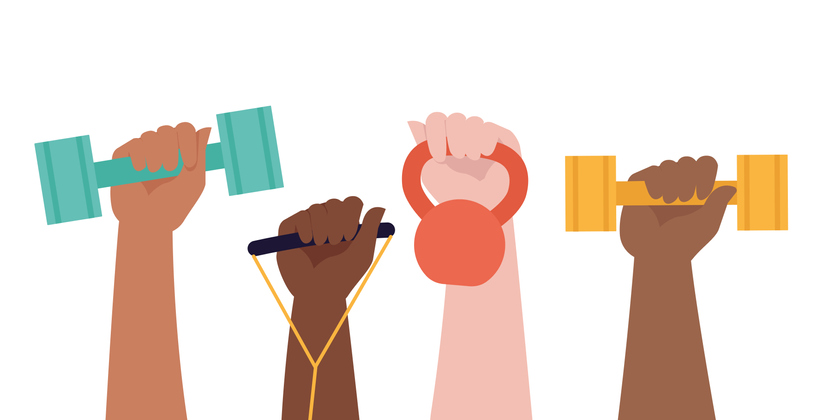 We’ve all taken a few weeks — even months — off from the gym. But what if it has been a few years since you’ve had a legit workout habit.
We’ve all taken a few weeks — even months — off from the gym. But what if it has been a few years since you’ve had a legit workout habit.
Don’t worry. These extended breaks can happen to the fittest of us. We get caught up with family, work and other responsibilities, or just fall out of our regular workout rhythm following an injury or illness. One skipped workout turns into a dozen and, before you know it, your workout pants turn into hack-around-the-house pants.
Trouble is, getting back into workouts and a consistent workout routine isn’t as easy as picking up where you left off. That’s why we’ve tapped the experts for five simple strategies that will help you get back into the groove — and stay in it for good.
Get Back into Workouts: How to Get Back in Shape, and Stay There
1. Consider why you took your hiatus in the first place.
To make this go at fitness a lifelong habit, you first have to figure out what derailed your last attempt, says Nancy Fudacz, NASM certified trainer and master performance training coach at the East Bank Club in Chicago. Did you get burned out with your routine? Did you hate the vibe — or even feel judged — at your gym?
Once you decide why you really (like, deep down) threw in the towel on your fitness all of those years ago, it’s your job not to let history repeat itself, says NYC-based psychologist Paul Hokemeyer, PhD. For instance, if you didn’t feel like you had the support you needed, it might be worth considering signing up for a regular group fitness class. If you always hated exercise because you viewed it as punishment for calories consumed, it’s time to start thinking of exercise as a form of self-care, he says. Dig deep, people!
RELATED: Too Depressed to Exercise?
2. Focus on where you were a week ago, not a year ago.
The harsh reality is that, if you aren’t training, you’re detraining, says Fudacz. So you aren’t going to be in the same shape you were when you first took your fitness hiatus, and you may very well have to “start over” gain. That can flat-out suck. After all, if you used to crank out push-ups like crazy — and can now barely get through 10 without dropping to the floor — it can be easy to get down on yourself.
To minimize the frustrations and negative self-talk, it’s important to think about your progress in terms of where you were during your hiatus, not where you during high school or the peak of your fitness, Fudacz says. “Progress isn’t linear,” she says. “We all have peaks and valleys, and simply being more active than you were last week is progress. You should be proud of that progress.”
3. Go back to the basics.
Similarly, whatever workouts become part of your fitness comeback, it’s important that you approach them with a slow-and steady pace, says Erica Suter, MS, CSCS, a Maryland-based trainer and strength coach. Pushing too hard or fast in the gym can contribute to frustrations, burnout, otherwise-avoidable exercise injuries and, in the end, another break from the gym.
Consider what feels doable — or even exciting — to you right now. “Training two to three days per week is an excellent start for the body to be able to smoothly adapt to a new program, while also avoiding any overtraining and fatigue,” Suter says. “Start with basic movement patterns that serve as the foundation for myriad exercises.” For instance, if you like strength training workouts, focus on mastering foundational bodyweight moves like squats and lunges before taking on more complicated variations.
“Once you’re in the meat and potatoes of your new workout program, really listen to your body and ask yourself if you are able to progress to more challenging movements or loads,” she says.
4. Experiment with new workouts.
When you return to the gym after some time off, it’s natural to hop back into the same workouts you did before. Instead, consider trying something new. That way, you will be less apt to compare your current exercise performance with that from years past. (Remember that whole “starting over” conundrum we talked about?)
Plus, when most people take an extended break from the gym, it has at least something to do with their workout. Maybe your old workout routine didn’t really motivate or give you the stress relief you needed. Even if you aren’t able to put your finger on the exact issue, trying out new workouts can be a great way of branching out and discovering fresh, fun ways to get moving.
RELATED: Is Online Personal Training Right for You?
5. Find your fitness tribe.
Not everyone’s a solo exerciser. And studies show there’s strength in numbers. For instance, in one Indiana University study, people who joined the gym solo had a 43 percent dropout rate over the course of the year. Meanwhile, those who went to the gym in pairs only had a 6.3 percent dropout rate. Surrounding yourself with folks with similar interests and goals will not only get you in the gym, it will help you get more out of your workouts, too, Fudacz says.
Give Yourself MORE 
Claim the positive: Embrace your strength, satisfy your appetite, prioritize joy, get more rest, and fall in love with your body. Be more authentically, unapologetically you. Weight loss is just one (of many) life-changing effects. It starts now.